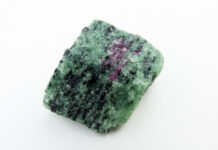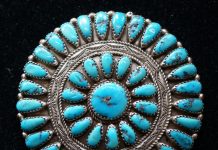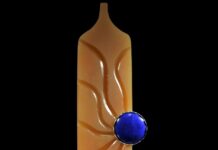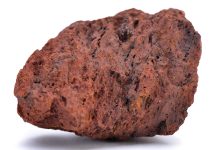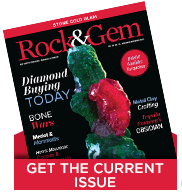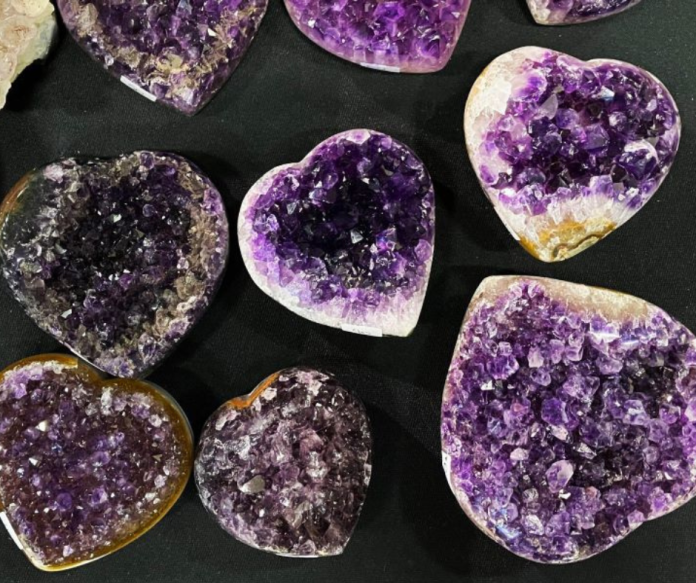
Heart-shaped stones, characterized by two curves meeting at a point at the bottom, are the universal symbol of love. At gem shows, carved heart-shaped stones line dealer tables and exhibit cases. Curious about the attraction to stones and jewelry shaped like hearts? Here’s a rundown of how the stylized heart shape came to be ubiquitous as a pictogram of love.
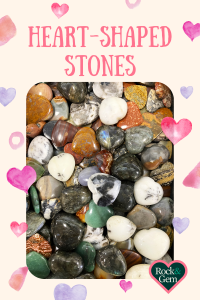
Natural Heart Shaped Stones
In pre-scientific times, Europeans occasionally found strange things weathering from the ground. These included fist-sized rocks looking more or less like hearts. In England, such rocky oddities were called Bulls’ Hearts and were described in 1677 by Robert Plot, who referred to them as Bucardites referring to Roman naturalist Pliny the Elder (c. 77 C.E.), who described “Bucardia stones” from Babylon resembling the heart of an ox.
When viewed from the side, these look like hearts printed on Valentine’s Day cards, but they are fossilized remains of clams. Sand or silt filled the original shell after the critters inside had died and dissolved. When the shells, buried in sediment, also dissolved in acidic groundwater, solidified internal molds of sandstone or siltstone were left. Tap on hardened sediment and the molds fall out cleanly. Germans called them steinkerns, or stone kernels. Excavating a Bronze Age burial mound at Albourne in Wiltshire, England dated between 3,300 and 1,200 B.C., archeologists found steinkerns placed alongside human remains. Such stones, apparently, were imbued with sufficient mystical power to be worthy of accompanying the dead into the afterlife.
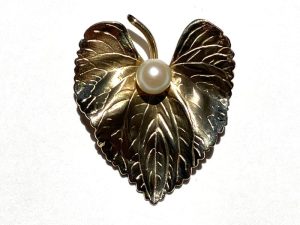
Animal, Vegetable or Mineral?
While we may associate heart-shaped stones with the heart, its origin may be more vegetable than animal. One prominent theory revolves around the northern African city-state of Cyrene (631 B.C. to 365 C.E). Cyrene started as a Greek colony and eventually became a Roman province before being leveled by an earthquake. It supplied Greeks and Romans with a now-extinct giant fennel called silphium, used as culinary flavoring and medicine. A major export, it was deemed important enough to the local economy to have its seed pod featured on Cyrenean coins. And that seed pod happens to be in the perfect form of a Valentine’s Day heart. Some speculate (without proof ) that its heart shape came to be associated with romantic love because, among its medicinal uses, silphium served as a contraceptive.
Heart Shapes From South Asia
One of the oldest examples of the heart shape being used in decorative arts comes from South Asia, where outlines resembling hearts adorned pottery as far back as 3,000 B.C. But these hearts, which have stems, were fashioned not after human hearts but after leaves of the peepal tree which eventually came to signify not romantic love, but the sacred. Also known as the Bodhi Tree or sacred fig, its heart-shaped leaves are said to have shaded a sitting Buddha (563-483 B.C.) as he attained enlightenment. The National Museum of India displays an ancient heart-shaped pendant fashioned after a peepal leaf and similar pendants are crafted and sold today.
Other more-or-less heart-shaped leaves of water lilies and ivy are featured in European iconography and heraldry of the Middle Ages. Ivy is considered a symbol of fidelity, so associating its heart shape with love is not a far stretch. However, one researcher emphasizes we’ve only made all these botanical associations in retrospect, and there’s no documented proof that the shapes of the silphium seed pod or various leaves were ever associated with love or led to the modern heart pictogram.
Views of the Ancients
Moving from vegetable to animal, ancient Egyptians, Hebrews, Greeks and Romans alike viewed the human heart as our center of feeling, passion and emotion. Forget the brain! Aristotle and others also saw the heart as the seat of thought, reason and conscience. Its association as the seat of emotions was cemented by Roman physician Galen (129-216 C.E.), considered the Father of Medicine. But rather than picture it as today’s traditional heart shape, he described it as being shaped like a pinecone, and there’s no evidence folks went about exchanging pine-cone-shaped jewels as expressions of love.
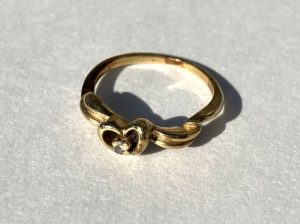
Medieval & Renaissance Courtly Love
As we’ve seen, the further back in time, the murkier and more speculative things are. There’s little evidence before the 1300s of the heart shape being explicitly associated with our contemporary love metaphor, but by the late Middle Ages, we see a clear connection. Medieval Europe is most often noted as the true birthplace and blossoming of the heart shape as emblematic of courtly romantic love. But it still wasn’t necessarily connected to the anatomical heart.
Soon enough, though, the heart shape did become associated with the very real heart. Early versions were depicted looking more like pinecones or pears and the first discern-ably “heart-shaped” images were depicted with the point up. This upside-down heart dominated until the late 14th century. Some early versions were perhaps a bit too realistic, if not downright grisly, by including the severed aorta and pulmonary artery. And then you have Sacred Hearts pierced by thorns and/or daggers and dripping blood. Doesn’t quite make the cut for a Hallmark card!
Ancient Texts
Some researchers argue the contemporary heart pictogram began to take shape when medieval physicians drew images derived from ancient medical texts. Given that those same ancient texts associated this vital organ with emotion, the shape was now becoming enshrined as a symbol of romance. This association was reinforced by a diagram in Thibaut’s French manuscript Roman de la poire (Romance of the Pear, c. 1250), where a kneeling man holds up his heart (or is it a pear?) to his lady love, and by Francesco da Barberino’s Documenti d’amore (Lessons about Love, c. 1315), which lays out precepts of chivalry, romance and courtly love. Soon, troubadours were writing poems and singing songs in which lovers pledged to link hearts.
By the 15th century, with the Renaissance underway, hearts had clearly taken on the anatomically inaccurate but aesthetically simpler, more pleasing shape we know today. In addition to songs and poems, heart-shaped jewelry, particularly rings and brooches, became extremely popular. Mary Queen of Scots is said to have gifted her cousin and rival Queen Elizabeth a ring with a heart-shaped diamond in 1562. Twenty-five years later, Elizabeth cut off Mary’s head, nonetheless.
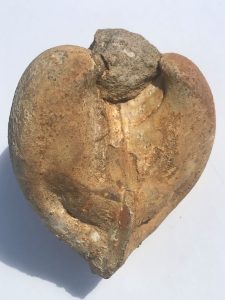
Heraldry & Playing Cards
In addition to jewelry, hearts became popular designs in medieval and Renaissance heraldry. Versions of the Danish state coat of arms going back to 1194 C.E. are adorned with three blue lions between lines of what appear to be nine red hearts. But, per the royal description of this seal, those are actually stylized lily pads (søblade, or “lake leaves”). Whether lake leaves or hearts, they began appearing in secular and religious seals, coats of arms, flags and other insignia. While the Sacred Heart of Christ became a popular religious motif during the Renaissance, on the secular side, the four-suit deck of playing cards, featuring hearts, spades, clubs and diamonds, emerged in France in the late 15th century. Hearts, it seemed, were everywhere.
Heart-Shaped Stones: The Hype of Victorian England
After the Renaissance, heart-shaped stones as jewelry went a bit out of vogue until the Romantic Period (roughly 1790-1840), which saw nostalgia for the Era of Chivalry as viewed through rose-colored glasses in light of rising industrialization. Britain’s Queen Victoria (1819-1901) was born into this period. She set fashion trends and was said to be especially fond of heart-shaped stones in jewelry as representative of love and devotion. This included romantic love toward Prince Albert with a heart locket containing a snippet of his childhood hair and maternal love toward their nine children, each represented by a heart-shaped charm on a bracelet.
Following the Queen’s example, heart-shaped stones as jewelry exploded in popularity. Betrothal rings included double hearts set side by side. Irish Claddagh rings displayed two hands holding one heart. Heart-shaped lockets with images or hair of a loved one became especially popular. The heart became cemented as the ultimate sentimental expression. During this time celebrations of Valentine’s Day (established for the martyred saint who aided lovers with secret marriages) went from the simple exchange of love notes adorned with hearts during the 17th century to a full-on industry of greeting cards.
Famous Heart-Shaped Stones
Some heart-shaped stones have achieved fame. Here are a few favorites.
- The Blue Heart Diamond: American heiress Marjorie Post gifted this 30.62ct diamond to the Smithsonian’s National Gem Collection in 1964. A lovely powder blue, it was cut from a 100.5ct rough from South Africa.
- The Cullinan Diamond V: One of nine diamonds cut from the largest gem-quality rough diamond ever found, this 18.8ct beauty was presented to Britain’s Queen Mary by the government of South Africa in 1910.
- The Heart of the Ocean Diamond: So what if Le Cœur de la Mer is fictional and crafted from deep blue cubic zirconia! This star of the 1997 Titanic movie was loosely modeled after the dazzling Hope Diamond.
- King Edward’s 20th Anniversary Brooch: Britain’s King Edward VIII chose love over a throne when he married Wallis Simpson. Forever regretful she never attained the title of Her Royal Highness, for their 20th anniversary he gifted her a heart-shaped Cartier brooch bedecked with emeralds, rubies and diamonds and capped by a crown.
- The Taj Mahal Diamond: Marking a tumultuous love story, Richard Burton gave this heart-shaped diamond to Elizabeth Taylor. Set in gray jadeite, this diamond pendant was originally a gift to Nur Jahan from her husband Emperor Jahangir Shah, who ruled India from 1605 to 1627.

Heart-Shaped Stones Today
Today, the heart pictogram is ubiquitous worldwide as a symbol of love and affection whether cut as a gemstone or forged in silver and gold, as a box holding chocolates, embossed on a Valentine’s Day card, or as an emoji at the tail end of Mom’s text message. It’s even become a hieroglyphic verb ever since graphic designer Milton Glaser first scribbled “I NY” in 1976 while riding in a cab with a piece of scrap paper and a red crayon.
Now that you know how it’s come to be, on this Valentine’s Day go out and gift a heart-shaped stone as a token of your love and devotion, friendship and affection.
This story about heart-shaped stones previously appeared in Rock & Gem magazine. Click here to subscribe. Story by Jim Brace-Thompson.


